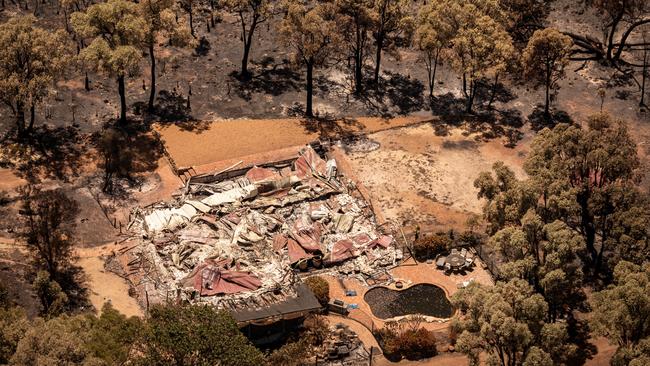WA fires under control, firey injured
Fire authorities in WA have stopped bushfires at Avon Ridge Estate and Shady Hills Estate which posed an overnight threat.

Fire authorities in Western Australia have stopped encroaching bushfires at Avon Ridge Estate and the Shady Hills Estate which posed a major overnight threat to lives and homes.
Fires on the western side and northern flank of the fire, fanned by strong south-easterly winds were brought under control by the retardant line laid by fire services yesterday.
The fire moved at 150 metres per hour in a north-westerly direction on Wednesday, after its perimeter grew to more than 120 kilometres.
South-easterly winds reached up to 70 kilometres per hour, with the wind changes not occurring until later in the afternoon.
More than 10,000 hectares of land have been burnt and hundreds of people have been evacuated.
There are no reports of loss of life, but one firefighter has been injured.
Authorities say the blaze will continue to pose a major challenge until the weekend, when weather conditions are expected to improve.
Superintendent Peter Sutton said “the situation remains the same in terms of the emergency warning”.
Addressing the press at the state’s Incident Control Centre, Premier Mark McGowan described the bushfires as unprecedented and extremely dangerous.
Fire property loss ‘tragic but foreseeable’
An apocalyptic cloud has lingered above Perth’s flat sandplains and eastern hills as firefighters battle an uncontrolled 80km firefront for a third day and Western Australia’s bushfire threatens to break records in its destructive path.
The fire that started on Monday in the rural outlying region of Wooroloo was still advancing towards bush blocks and housing estates in Shady Hills and the RAAF base at Bullsbrook on the northeastern outskirts of Perth.
Fire and Emergency Services deputy commissioner Craig Waters said late on Wednesday that inaccessible hill terrain meant some fires would advance unchecked for the next few days. “We expect a mild cool change later in the week will give some respite to firefighters,” he said.
Residents on the threatening north and south flanks of the fire were being urged to evacuate late into the day because of strong winds. About 1300 homes and businesses are still without power in parts of Mundaring and Bullsbrook shires and the City of Swan.
Evacuee Elizabeth Kiernan, from Annie’s Landing, near Ellenbrook, spent two days in a tent with her dogs on the oval at Swan View evacuation centre after waking at 2am on Tuesday and seeing “a huge red glow in the sky”.
She said a large cloud plume still hung over her house when she was permitted to return home late on Wednesday. Road blocks remain in fire-prone areas, with no property owners allowed to enter for at least 24 hours.
Premier Mark McGowan said: “Homes and memories are going up in flames. It’s incredibly sad.”
The federal government has approved immediate disaster relief for victims of the Wooroloo bushfires, with payments of up to $1000 per adult and $400 per child. Mr McGowan also announced $2m would go to a distress relief fund in the wake of confirmation that at least 71 homes had been lost in the blaze.
If that figure exceeds 71, it will put the Wooroloo fire at the top of WA’s most destructive bushfire rankings, ahead of the same number of houses lost in the 2011 Roleystone fires in Perth’s hills. Murdoch University ecologist and fire science expert Joe Fontaine said Perth’s latest bushfire loss was “tragic but foreseeable”.
“The warming and drying climate increases the probability of bushfire spread and difficulty of suppression,” he said. “The risk of bushfire and home loss in this area is widely known and presaged by the Toodyay bushfire in 2009.”
He said most fire ignitions in southwestern Australia were human, so the ability to respond before fires developed was difficult. Police are investigating whether the Wooroloo fire is linked to the letting off of fireworks on private property.
Many destroyed houses were at Tilden Park, a leafy enclave of animal owners and rural dwellers 50km northeast of Perth.
Nearly 80 per cent of Tilden Park’s houses, many built less than 20 years ago, have gone.
Jodi Cant, director general of the state’s Department of Finance, was left contemplating a charred pile of metal, all that remained of her Tilden Park home purchased in 2004.
Ms Cant, whose department funds the fire service that she praised for saving her shed, said her entire house and contents were destroyed, yet the properties of her six surrounding neighbours remained unscathed.
“I’ve lost all my books, my art, all Gran’s photograph albums and the videos of all the horses I’ve owned,” Ms Cant said.



To join the conversation, please log in. Don't have an account? Register
Join the conversation, you are commenting as Logout